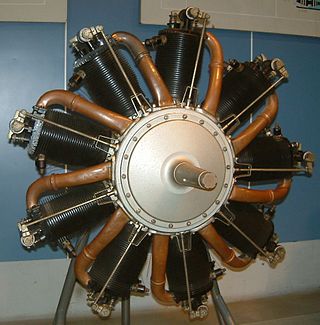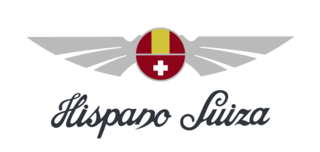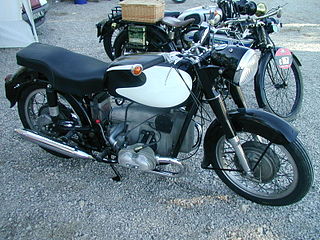
Bayerische Motoren Werke AG, commonly abbreviated to BMW, is a German multinational manufacturer of luxury vehicles and motorcycles headquartered in Munich, Bavaria, Germany. The company was founded in 1916 as a manufacturer of aircraft engines, which it produced from 1917 to 1918 and again from 1933 to 1945 creating engines for aircraft that were used in the Second World War.

The rotary engine is an early type of internal combustion engine, usually designed with an odd number of cylinders per row in a radial configuration. The engine's crankshaft remained stationary in operation, while the entire crankcase and its attached cylinders rotated around it as a unit. Its main application was in aviation, although it also saw use in a few early motorcycles and automobiles.

Messerschmitt AG was a German share-ownership limited, aircraft manufacturing corporation named after its chief designer Willy Messerschmitt from mid-July 1938 onwards, and known primarily for its World War II fighter aircraft, in particular the Bf 109 and Me 262. The company survived in the post-war era, undergoing a number of mergers and changing its name from Messerschmitt to Messerschmitt-Bölkow-Blohm before being bought by Deutsche Aerospace in 1989.

Hispano-Suiza is a Spanish automotive company. It was founded in 1904 by Marc Birkigt and Damián Mateu as an automobile manufacturer and eventually had several factories in Spain and France that produced luxury cars, aircraft engines, trucks and weapons.

The Europrop International TP400-D6 is an 11,000 shp (8,200 kW) powerplant, developed and produced by Europrop International for the Airbus A400M Atlas military transport aircraft. The TP400 is the most powerful turboprop in service using a single propeller; only the Kuznetsov NK-12 from Russia and Progress D-27 from Ukraine, using contra-rotating propellers, is larger.

Anzani was an engine manufacturer founded by the Italian Alessandro Anzani (1877–1956), which produced proprietary engines for aircraft, cars, boats, and motorcycles in factories in Britain, France and Italy.

The Hispano-Suiza 8 is a water-cooled V8 SOHC aero engine introduced by Hispano-Suiza in 1914 that went on to become the most commonly used liquid-cooled engine in the aircraft of the Entente Powers during the First World War. The original Hispano-Suiza 8A was rated at 140 hp (100 kW) and the later, larger displacement Hispano-Suiza 8F reached 330 hp (250 kW).

Hamilton Standard was an American aircraft propeller parts supplier. It was formed in 1929 when United Aircraft and Transport Corporation consolidated Hamilton Aero Manufacturing and Standard Steel Propeller into the Hamilton Standard Propeller Corporation. Other members of United Aircraft included Boeing, United Airlines, Sikorsky and Pratt & Whitney. At the time, Hamilton was the largest manufacturer of aircraft propellers in the world.

Avia Motors s.r.o. is a Czech automotive manufacturer. Founded in 1919 as an aircraft maker, it diversified into trucks after 1945. As an aircraft maker it was notable for producing biplane fighter aircraft, especially the B-534. Avia ceased aircraft production in 1963.

Gnome et Rhône was a major French aircraft engine manufacturer. Between 1914 and 1918 they produced 25,000 of their 9-cylinder Delta and Le Rhône 110 hp (81 kW) rotary designs, while another 75,000 were produced by various licensees. These engines powered the majority of aircraft in the first half of the war, both Allied designs as well as German examples produced by Motorenfabrik Oberursel.

In aeronautics, a variable-pitch propeller is a type of propeller (airscrew) with blades that can be rotated around their long axis to change the blade pitch. A controllable-pitch propeller is one where the pitch is controlled manually by the pilot. Alternatively, a constant-speed propeller is one where the pilot sets the desired engine speed (RPM), and the blade pitch is controlled automatically without the pilot's intervention so that the rotational speed remains constant. The device which controls the propeller pitch and thus speed is called a propeller governor or constant speed unit.
The Automobilwerk Eisenach (AWE) was an automobile manufacturer in Eisenach, Germany.

Douglas was a British motorcycle manufacturer from 1907 to 1957 based in Kingswood, Bristol, owned by the Douglas family, and especially known for its horizontally opposed twin cylinder engined bikes and as manufacturers of speedway machines. The company also built a range of cars between 1913 and 1922.
Buchet was a French motorcycle and automobile manufacturer between 1899 and 1930.
The history of the motorcycle begins in the second half of the 19th century. Motorcycles are descended from the "safety bicycle," a bicycle with front and rear wheels of the same size and a pedal crank mechanism to drive the rear wheel. Despite some early landmarks in its development, the motorcycle lacks a rigid pedigree that can be traced back to a single idea or machine. Instead, the idea seems to have occurred to numerous engineers and inventors around Europe at around the same time.

The official founding date of the German motor vehicle manufacturer BMW is 7 March 1916, when an aircraft producer called Bayerische Flugzeugwerke was established. This company was renamed to Bayerische Motoren Werke (BMW) in 1922. However, the BMW name dates back to 1917, when Rapp Motorenwerke changed its name to Bayerische Motoren Werke. BMW's first product was a straight-six aircraft engine called the BMW IIIa. Following the end of World War I, BMW remained in business by producing motorcycle engines, farm equipment, household items and railway brakes.

The Centre d'études de moteurs à explosion et à combustion (Explosion and Combustion Engines Studies Center) (CEMEC) was a company that continued the construction of BMW motorcycles taken from the German occupying forces after the Second World War. It was founded in 1945 as the Centre de montage et de récupération (CMCR) (English: Assembly and Repair Centre) at Neuilly-sur-Seine. It was renamed CEMEC in 1947.

Osborn Engineering Company was a British manufacturer of motorcycles, which sold its machines under the OEC brand name.

Capriolo, later called Aeromere, was the name of the motorcycle production arm of the Italian aircraft company Aeromere or Aero-Caproni. After World War II, the victorious Allies prohibited wartime aircraft and other military hardware suppliers from remaining in their previous industries, and Aero-Caproni would change its name to Capriolo and become one of several, including Aermacchi, MV Agusta, Vespa and Ducati, that switched to producing motorcycles or scooters. These companies did well until the mid-1960s, when the advent of affordable cars like the Fiat 500 removed the economic barrier that kept many Italians relying on motorcycles for basic transportation. Capriolo was typical of those that could not survive the transformation to a more export-orientated industry, with the US as the most important market. Motorcycle production ran from 1947 or 1948 until 1964.
















